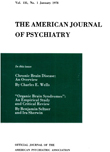EXHAUSTION SYNDROME IN EXCITED PSYCHOTIC PATIENTS
Abstract
1. The need for recognizing an exhaustion syndrome in acutely excited psychotic patients, in order to be on guard for, and to prevent, sudden death from this complication, is stressed.
2. The exhaustion syndrome in acutely excited psychotic patients consists of: a. sustained motor and mental excitement; b. rapid thready pulse; c. rapid loss in body weight; d. profuse clammy perspiration; e. fall in blood and pulse pressure; f. hyperpyrexia.
3. The causes of this syndrome appear to include a predisposing parasympathetic nervous system ascendancy in the neural and vascular interrelations (modified by emotional autonomic reflexes) and direct mechanico-functional factors of accumulation of toxemic catabolites, malnourishment, dehydration, sodium loss, and lowered secretion of adrenal cortical hormones, with sustained small blood vessel dilatation and blood stasis.
4. Reports of this condition up to 1944 have revealed 403 deaths, but no recoveries.
5. In 1944, this writer reported 2 cases of recovery and in this paper adds 7 cases of recovery from the exhaustion syndrome in acutely excited psychotic patients following the early institution of a full array of therapy.
6. Therapy successfully relieving acutely excited psychotic patients from the exhaustion syndrome consists of (besides general nursing care): a. institution of therapy before hyperpyrexia reaches 105° F. (R); b. adequate sedation by chemical and physical means; c. adequate nourishment by tube feeding and intravenous infusions; d. sodium replacement; e. regular instillations of adrenal cortical extract.
Access content
To read the fulltext, please use one of the options below to sign in or purchase access.- Personal login
- Institutional Login
- Sign in via OpenAthens
- Register for access
-
Please login/register if you wish to pair your device and check access availability.
Not a subscriber?
PsychiatryOnline subscription options offer access to the DSM-5 library, books, journals, CME, and patient resources. This all-in-one virtual library provides psychiatrists and mental health professionals with key resources for diagnosis, treatment, research, and professional development.
Need more help? PsychiatryOnline Customer Service may be reached by emailing [email protected] or by calling 800-368-5777 (in the U.S.) or 703-907-7322 (outside the U.S.).



